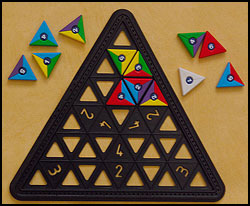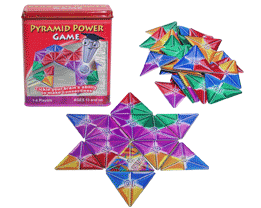
Triominoes is a variant of dominoes using triangular tiles published in 1965. A popular version of this game is marketed as Tri-Ominos by the Pressman Toy Corp. [1]

Triominoes is a variant of dominoes using triangular tiles published in 1965. A popular version of this game is marketed as Tri-Ominos by the Pressman Toy Corp. [1]
A triomino tile is in the shape of an equilateral triangle approximately 1 in (2.5 cm) on each side and approximately 1⁄4 in (6.4 mm) thick. Each point of the triangle has a number (most often from 0 to 5, as in the Pressman version), [2] and each triomino has a unique combination of numbers, subject to the following restrictions:
Given these restrictions, with the six potential values (0–5) commonly seen, there are 56 unique combinations, and thus the standard triomino set has 56 tiles. Larger sets are possible; for example, including 6 as a possible end number would result in 84 tiles.
Tiles are most often made from plastic or resin that approximates the feel of stone or ivory, similar to most modern commercial domino sets. Numbers are recessed into the surface and painted black. Some "deluxe" sets include a raised, brass tack head in the center. This addition to the sets assists in mixing up or shuffling tiles, as the tack head reduces the surface area of the tile contacting the table, so tiles move more freely.
At the start of the game, all of the tiles are placed face down and shuffled. Players randomly draw their starting pieces. The specific number depends upon the number of players: a two-player game uses nine pieces per player to start, three or four players use seven pieces, and five or six players use six pieces. The tiles after the draw are kept face-down for later use. [3]
One player keeps score for all, using columns for each player and cumulative scores. [3]
The player who draws the largest "triple" (all three numbers the same on the tile), begins the game by placing that tile. That player scores 10 points plus the total value of the tile. The exception is that if the triple zero tile is used to start, that player earns 40 points. [3] In this case, the only triple tile held is the triple zero, which would otherwise be trumped by any other triple tile.
If no triple is held by any player, the player with the highest single tile value plays it and scores its value without the 10 point bonus. Tile values are computed by summing the three numbers. For example, the 2-4-5 tile is worth 2+4+5=11 points. [3] When two or more players hold tiles with the same summed value, the next highest counts and so on until there is the highest value tile.
Play proceeds clockwise; each player places a tile from their hand that lines up with the already placed tiles. A valid play of a triomino is similar to that of a domino in that the sides contacting each other must have matching numbers; this means the two numbers at the corners must match with the adjacent tile. [3] A side with a 1 and a 2 will often not match the side the player is attempting to match. If a new tile is being placed such that it would touch two other tiles, then all of the adjacent numbers must match. Where the points of tiles meet the numbers must always be the same; if they are not, someone has been allowed to misplace a tile and the round must be restarted.
Points are scored based on the numbers on the tile played, with additional bonuses applied when special placements are made. After a tile has been placed legally, each number on the newly placed tile is summed and added to that player's score. (E.g. 5 + 3 + 1 = 9).
If a player cannot place a piece using the tiles in their hand, they must draw a new piece from the remaining pile. Each tile drawn penalizes the player 5 points. [3] Players must continue to draw until a matching tile is found or until they have drawn three tiles. If one of the three can be placed the score is the value of the tile placed less the penalty, which may be positive or negative, depending on the placed tile value and number of tiles drawn. If none of these three tiles can be placed the penalty is 25 points.
If there are no remaining tiles left to be drawn and a player is unable to place a tile, they lose 10 points. For example, if there are two tiles left, a player without a tile to be placed may draw them (receiving a penalty -10 in total for the two tiles drawn), and if that player still has no tile that can be played, the additional end penalty is incurred (total penalty -10 + -10).
When a player can place a tile that completes a closed hexagonal shape (i.e. the 6th piece & all 3 numbers match), that player receives a bonus of 50 points plus the regular score for a legally placed tile, less any penalty if pieces have been drawn. If a player completes two hexagons in one move the player receives a 100 point bonus.
Bridges are made by matching one side of the tile and the point opposite. If a bridge is completed or a tile is added to a bridge, that player receives a 40-point bonus in addition to the tile's points, less any penalty if pieces have been drawn.
The round ends when no player can place a tile, whether or not all the face-down tiles have been drawn, or when one player runs out of tiles.
Additional rounds are played until one player reaches a total of 400 points. They are not yet the winner, and may not be: this only signals that this is the last round, even if penalties later reduce their total below 400. The winner is the one who has the most points at the end of this last round.

The game includes only 56 out of 76 possible tiles, omitting those tiles in which the numbers appear in clockwise descending order; i.e., where 0-1-2 is a possible tile, the mirror-image reflection 0-2-1 is not. Consequently, there are many situations in which no tile completes a bridge or hexagon. This lack of symmetry means the game has only one of two tile patterns with Cis–trans isomerism, i.e., with three different numbers on the tile.
With only one of the two patterns, there are 21 tiles with one or more of a particular number e.g. there are 21 tiles with one or more "5". There are 6 tiles with any combination of two numbers e.g. there are 6 tiles with one or more 4 and one or more 5. The count to arrive at 56 possible tiles goes then as follows:
The last one is the triple zero obviously.
Much depends on the luck of the draw, but skill plays a part, even if a small one. Players should be aware that they hold a matching tile or tiles and need to decide whether or not to play them or in which order to play them for their best advantage. They should be aware of potential hexagons or bridges, to avoid misplacing a tile that could be valuable. A player may consider it worthwhile to set up potential hexagons and bridges since this may or may not be to his own benefit; they may even hold the necessary tile to use in his next move. He may feel that placing a tile to which others can be matched is preferable to placing it to form an "impossible" hexagon or bridge.
In 2009, an app for the iPhone was launched which licensed the Tri-ominos brand from Pressman. [4] [5] A new app was launched in 2015, coinciding with Triominos' 50th anniversary. [6]
Variants manufactured by Pressman have included "Quad-Ominos", with square-shaped tiles, and "Picture Tri-Ominos". [7]

Mahjong is a tile-based game that was developed in the 19th century in China and has spread throughout the world since the early 20th century. It is played by four players. The game and its regional variants are widely played throughout East and Southeast Asia and have also become popular in Western countries. The game has also been adapted into a widespread online entertainment. Similar to the Western card game rummy, mahjong is a game of skill, strategy, and luck. To distinguish it from mahjong solitaire, it is sometimes referred to as mahjong rummy.

Scrabble is a word game in which two to four players score points by placing tiles, each bearing a single letter, onto a game board divided into a 15×15 grid of squares. The tiles must form words that, in crossword fashion, read left to right in rows or downward in columns and are included in a standard dictionary or lexicon.
Rubber bridge is a form of contract bridge played by two competing pairs using a particular method of scoring. A rubber is completed when one pair becomes first to win two games, each game presenting a score of 100 or more contract points; a new game ensues until one pair has won two games to conclude the rubber. Owing to the availability of various additional bonus and penalty points in the scoring, it is possible, though less common, to win the rubber by amassing more total points despite losing two games out of three. Rubber bridge involves a high degree of skill but there is also a fair amount of luck involved in who gets the best cards. A popular variation of rubber bridge is known as Chicago.
Japanese Mahjong scoring rules are used for Japanese Mahjong, a game for four players common in Japan. The rules were organized in the Taishō to Shōwa period as the game became popular.

Golf is a card game where players try to earn the lowest number of points over the course of nine deals.

Rummikub is a tile-based game for 2 to 4 players, combining elements of the card game rummy and mahjong. There are 106 tiles in the game, including 104 numbered tiles and two jokers. Players have 14 tiles initially and take turns putting down tiles from their racks into sets of at least three, drawing a tile if they cannot play. Players have a two-minute time limit for their turn. In the Sabra version, the first player to use all their tiles scores a positive score based on the total of the other players' hands, while the losers get negative scores. Variations of the game contain four jokers. An important feature of the game is that players can move and reuse the tiles that have already been placed on the table. The game can also be played with 2 decks of playing cards with suit being different colors and number as follows : Ace = 1, Number 2-10 = their number, Jack = 11, Queen = 12, King = 13 and with Jokers.
Scrabble variants are games created by changing the normal Scrabble rules or equipment.
While a deal of bridge is always played following a unique set of rules, its scoring may vary depending on the type of event the deal is played on. There are two main categories of scoring: rubber and duplicate. Rubber scoring, and its popular variant Chicago, are mostly used in social play. Duplicate scoring is focused on tournament competition and has many variations that compare and rank the relative performance of partnerships and teams playing the same deals as their competitors.

Ingenious is the English name for Einfach Genial, a German abstract strategy board game designed by Reiner Knizia under commission from Sophisticated Games and published in 2004 by Kosmos. Across most of Europe it is titled as the local translation of Ingenious or Simply Ingenious, the notable exception being Mensa Connections in the UK.

Take It Easy is an abstract strategy board game created by Peter Burley. It can be characterized as a strategic bingo-like game, and has been published by Ravensburger and subsequently by several other publishers since 1983.
mi×ma+h is a Canadian board game developed by Wrebbit and published in 1987. It resembles a variant of Scrabble in that tiles are placed on a crossword-style grid, with special premiums such as squares that double or triple the value of a tile and a 50-point bonus for playing all seven tiles on the player's rack in one turn. Unlike Scrabble, Mixmath uses numbered tiles to generate short equations using simple arithmetic. Wrebbit, maker of Puzz-3D jigsaw puzzles, has since been taken over by Hasbro, and it appears that Mixmath has been discontinued.

Okey is a tile-based game, popular in Turkey, of the rummy family. The aim of the game is to score points against the opposing players by collecting certain groups of tiles. It is usually played with four players, but can also be played with only two or three players.

Spectrangle is a triangular tile-based abstract strategy game invented by Alan John Fraser-Dackers, Maxwell Graham Gordon and Lester Wynne Jordan. The principles behind the game are based on the work of British mathematician Percy Alexander MacMahon. The original game was for up to 8 players and used 60 tiles. A later more compact version for up to four players uses 36 tiles. It is this version that is described here.
A number of related games under the Yahtzee brand have been produced. They all commonly use dice as the primary tool for game play, but all differ generally. As Yahtzee itself has been sold since 1954, the variants released over the years are more recent in comparison, with the oldest one, Triple Yahtzee, developed in 1972, eighteen years after the introduction of the parent game.

Pyramid Power is a tile game, where the goal is to score points by placing triangle-shaped tiles next to other triangle-shaped tiles so that the colors on the touching faces match. Doing so scores the player points. It was published by Winning Moves Games USA in 2008 and is one of three games in their Brain-Ade line of quick puzzle games and features both multiplayer and solitaire versions. This game is no longer in production.
Japanese mahjong, also known as riichi mahjong, is a variation of mahjong. While the basic rules to the game are retained, the variation features a unique set of rules such as riichi and the use of dora. The variant is one of a few styles where discarded tiles are ordered rather than placed in a disorganized pile. This is primarily due to the furiten rule, which takes player discards into account. The variant has grown in popularity due to anime, manga, and online platforms.

Three-player mahjong is a variation of mahjong for three players rather than the more common four-player variations. It is not a mere adaption of four-player mahjong to suit only three players but has its own rules and idiosyncrasies that place it apart from the more standard variations. The equipment used and the basic mechanisms are much like four-player variations though some tiles are removed, certain plays are prohibited and the scoring system is simplified. The game is embraced in some Asian countries while ignored or snubbed in others.
Le Trioker is a corner-matching puzzle game played using 25 equilateral triangle-shaped tiles. Each corner is marked with zero, one, two, or three dots and newly placed pieces must match the values on pieces already placed on the game board, similar to the gameplay of the earlier Triominoes.

Contack is a dominoes-like game for one to seven players which was patented by Parker Brothers and published in 1939. It uses 36 equilateral triangle tiles; each side is assigned a different color and numerical value. Players take turns laying tiles from a hand of five next to tiles already on the table; newly-laid tiles must match the color of adjacent tile(s).